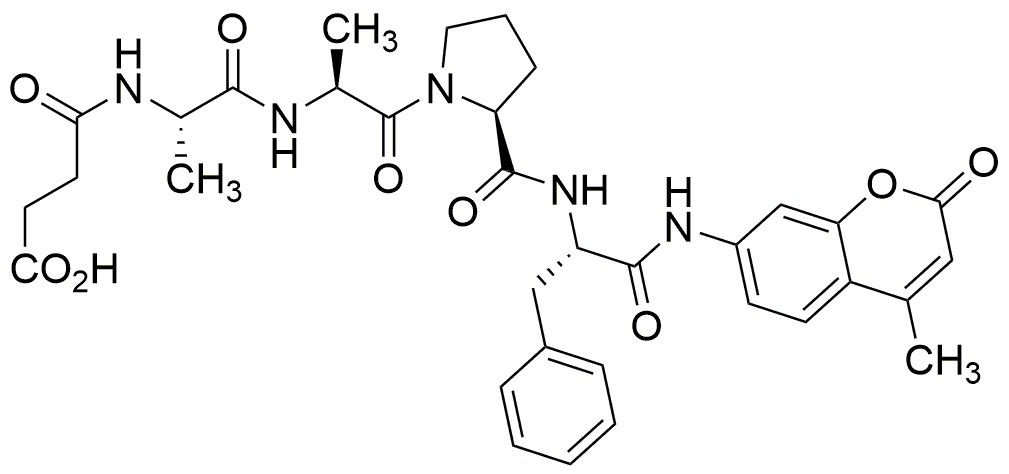Suc-Ala-Ala-Pro-Phe-AMC is widely utilized in research focused on:
- Protease Activity Assays: This compound serves as a substrate for various proteases, enabling researchers to measure enzyme activity in biochemical assays. Its specificity allows for precise monitoring of proteolytic processes.
- Drug Development: In pharmaceutical research, it aids in the screening of potential drug candidates by providing insights into enzyme interactions, helping to identify effective inhibitors or activators.
- Biomarker Discovery: The compound is used in studies aimed at discovering new biomarkers for diseases, particularly in cancer research, where proteolytic activity can indicate disease progression.
- Peptide Synthesis: It plays a role in the synthesis of peptides in the lab, providing a building block for creating more complex peptide structures that can be used in therapeutic applications.
- Diagnostics: This chemical is utilized in diagnostic assays to detect protease-related diseases, offering a reliable method for early disease detection and monitoring treatment efficacy.
General Information
Properties
Safety and Regulations
Applications
Suc-Ala-Ala-Pro-Phe-AMC is widely utilized in research focused on:
- Protease Activity Assays: This compound serves as a substrate for various proteases, enabling researchers to measure enzyme activity in biochemical assays. Its specificity allows for precise monitoring of proteolytic processes.
- Drug Development: In pharmaceutical research, it aids in the screening of potential drug candidates by providing insights into enzyme interactions, helping to identify effective inhibitors or activators.
- Biomarker Discovery: The compound is used in studies aimed at discovering new biomarkers for diseases, particularly in cancer research, where proteolytic activity can indicate disease progression.
- Peptide Synthesis: It plays a role in the synthesis of peptides in the lab, providing a building block for creating more complex peptide structures that can be used in therapeutic applications.
- Diagnostics: This chemical is utilized in diagnostic assays to detect protease-related diseases, offering a reliable method for early disease detection and monitoring treatment efficacy.
Documents
Safety Data Sheets (SDS)
The SDS provides comprehensive safety information on handling, storage, and disposal of the product.
Product Specification (PS)
The PS provides a comprehensive breakdown of the product’s properties, including chemical composition, physical state, purity, and storage requirements. It also details acceptable quality ranges and the product's intended applications.
Certificates of Analysis (COA)
Search for Certificates of Analysis (COA) by entering the products Lot Number. Lot and Batch Numbers can be found on a product’s label following the words ‘Lot’ or ‘Batch’.
*Catalog Number
*Lot Number
Certificates Of Origin (COO)
This COO confirms the country where the product was manufactured, and also details the materials and components used in it and whether it is derived from natural, synthetic, or other specific sources. This certificate may be required for customs, trade, and regulatory compliance.
*Catalog Number
*Lot Number
Safety Data Sheets (SDS)
The SDS provides comprehensive safety information on handling, storage, and disposal of the product.
DownloadProduct Specification (PS)
The PS provides a comprehensive breakdown of the product’s properties, including chemical composition, physical state, purity, and storage requirements. It also details acceptable quality ranges and the product's intended applications.
DownloadCertificates of Analysis (COA)
Search for Certificates of Analysis (COA) by entering the products Lot Number. Lot and Batch Numbers can be found on a product’s label following the words ‘Lot’ or ‘Batch’.
*Catalog Number
*Lot Number
Certificates Of Origin (COO)
This COO confirms the country where the product was manufactured, and also details the materials and components used in it and whether it is derived from natural, synthetic, or other specific sources. This certificate may be required for customs, trade, and regulatory compliance.


